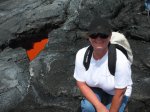Candice Hansen: Get involved with an instrument team
 Dr. Candice Hansen has worked on Voyager, Cassini, Mars Polar Lander, Mars Reconnaissance Orbiter, and Juno, writing or contributing to more than 250 journal articles. Her research includes work on ices, tenuous atmospheres in vapor pressure equilibrium with surface ices, and seasonal processes, as well as the plumes on Enceladus and Triton. She is a senior scientist with the Planetary Science Institute.
Dr. Candice Hansen has worked on Voyager, Cassini, Mars Polar Lander, Mars Reconnaissance Orbiter, and Juno, writing or contributing to more than 250 journal articles. Her research includes work on ices, tenuous atmospheres in vapor pressure equilibrium with surface ices, and seasonal processes, as well as the plumes on Enceladus and Triton. She is a senior scientist with the Planetary Science Institute.
Her most recent publication is:
- Hansen, C. J., N. Thomas, G. Portyankina, A. McEwen, T. Becker, S. Byrne, K. Herkenhoff, H. Kieffer, M. Mellon, “HiRISE observations of gas sublimation-driven activity in Mars’ southern polar regions: I. Erosion of the Surface”, Icarus 205:283-295 (2010).
1. What inspired you to study space science?
As a teenager I loved science fiction, but I never imagined myself exploring the solar system. When I started college (CSUF) a general science course was required and physics fit conveniently into my schedule. I loved it and switched my major. It still wasn’t clear to me what type of career that would lead to, but then I took a class in planetary science from a young woman professor that had worked on the Apollo program (Dr. Dorothy “Dottie” Woolum). She was an important mentor, and I had found my career direction.
2. What brought you to JPL? Was it Voyager, or did you get involved in that work later?
After completing my B.A. in Physics at Calif. State University Fullerton I went to the University of Arizona in Tucson to start graduate school. I hated Tucson at the time so I talked my research advisor, Dr. Brad Smith, the team leader of the Voyager Imaging Team, into sending me to JPL for the summer. I fell in love with JPL on my first day, and set about trying to find a permanent job. It turned out that one of my physics colleagues, Dr. Linda Spilker, had landed a job on the Voyager flight team, and she got me an interview with her boss. It was just a few months before launch and they were staffing up for spacecraft operations, so I was hired.
I worked for the Voyager Imaging Team through the Jupiter and Saturn flybys, went to work in Europe for the German Space Operations Center between Saturn and Uranus, worked the Uranus flyby, had my daughter and returned to graduate school between Uranus and Neptune, worked the Neptune flyby, then finished my Ph.D. partially using Voyager Triton data for my dissertation. So Voyager was a key part of my life for 12 years. One evening I was out giving a Voyager talk as outreach and met my husband, so Voyager was even responsible for me being happily married now.
3. How do you balance your mission work with research?
It is not easy to balance mission work with research because mission work is very demanding in terms of critical events and deliverables. Spacecraft do not observe holidays or care about conferences. So my approach has been to schedule time to do research in the same way that I schedule meetings on my calendar. If I have scheduled an afternoon to work on, for example, HiRISE data I won’t even read my email until the evening.
4. What else is important to you?
I love variety – currently I’m working on Cassini, Mars Reconnaissance Orbiter, and Juno. Each is fascinating in its own way. But it’s important to have a life outside of your work, particularly because in this field there are no guarantees. I worked on Mars Polar Lander, and its loss was devastating, but not the end of the world. My family, my dogs, hiking, and boating, are all important to me too.
5. What advice do you have for a young scientist wanting to work on flight missions?
Get involved with an instrument team. You will have the excitement of being part of a flight mission, from the challenges of designing an instrument to return the data that will address an important scientific goal, to seeing the data coming back, to interpreting what the results mean. There is nothing more rewarding!
Thank you, Dr. Hansen!
Dr. Hansen is being featured here as one of 51 Women in Planetary Science, a series of interviews with successful women scientists on career choices, sequencing, publishing, review panels, and other tips for success. Questions or suggestions for future interviews can be sent to us directly or to our email list, which all women in planetary science can join!



What a good way to start the day: reading about Space SuperWomen.
Thanks for this, Susan.